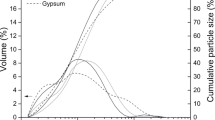Abstract
Normal portland cement, low C3A cement, tricalcium silicate, and C3A—gypsum mixtures are hydrated in the presence of 0, 0.8, 1.5 and 3.0% CaCl2 for 1, 3, 7, 14 and 28 days and the amounts of extractable chloride determined by applying a pressure of 80 000 lb (449 MPa) or by treating the pastes with excess water. At early periods of hydration both methods yielded similar values for immobilized chloride. The amount of free chloride in the pore solution increased as the dosage of initially added chloride was increased. The C3A—gypsum mixture immobilized much higher amounts of chloride than did the C3S phase. Normal portland cement had lower amounts of free chloride than low C3A cement.
Résumé
Du ciment Portland normal, du ciment CAP, du silicate tri-calcique et des mélanges de C3A-plâtre sont hydratés en présence de 0, 0,8, 1,5 et 3% de CaCl2 en 1, 3, 7, 14 et 28 jours; les quantités de chlorure que l'on peut extraire sont déterminées par application d'une pression de 449 MPa ou par traitement des pâtes avec un excès d'eau. Dans les premiers temps de l'hydratation les deux méthodes donnent des quantités voisines de chlorure retenu. La quantité de chlorure libre dans la solution interstitielle augmente avec le dosage de chlorure initialement ajouté. Le mélange de C3A-plâtre retient des quantités beaucoup plus grandes de chlorure que ne le fait la phase C3S. Le ciment Portland normal montre des quantités plus faibles de chlorure libre que le ciment CAP.
Similar content being viewed by others
References
Monfore G. E., andVerbeck G. J.—Corrosion of prestressed wire in concrete, in Proceedings of the American Concrete Institute, Vol. 57, pp. 491–515, 1960.
Rosenberg A. M.—Study of the mechanism through which calcium chloride accelerates the set of portland cement, in Proceedings of the American Concrete Institute, Vol. 61, pp. 1261–1268, 1964.
Wolhutter C. W., andMorris R. M.—Aspects of steel corrosion in concrete, Civil Engineering in South Africa, Vol. 15, pp. 245–250, 1973.
Roberts M. H.—Effect of calcium chloride on the durability of pretensioned wire in prestressed concrete, Magazine of Concrete Research, Vol. 14, pp. 143–154, 1962.
Mehta P. K.—Effect of cement composition on corrosion of reinforcing steel in concrete, American Society for Testing and Materials, STP 629, pp. 12–19, 1977.
Cook H. K., andMcCoy W. J.—Influence of chloride in reinforced concrete, American Society for Testing and Materials, STP 629, pp. 20–29, 1977.
Influence of calcium chloride admixture on reinforced corrosion in concrete, Cement Research Institute of India, p. 21, 1977.
Theissing E. M., Hest-Wardenier P. V. andde Wind G. —The combining of sodium chloride and calcium chloride by a number of different hardened cement pastes, Cement and Concrete Research, Vol. 8, pp. 683–692, 1978.
Ramachandran V. S.—Calcium chloride in concrete: Science and technology, Applied Science Publishers Ltd., London, 216 p. 1976.
Diamond S., andFederico L. F.—Fate of calcium chloride dissolved in concrete mix water, Journal of the American Ceramic Society, Vol. 64, pp. 162–164, 1981.
Kurbatova I. I., andAbramkina V. G.—Kinetics of crystallization of products formed in cement pastes with additions of calcium chloride, Journal of Applied Chemistry, USSR, Vol. 49, pp. 1064–1067, 1976.
Ramachandran V. S.—Possible states of chloride in the hydration of tricalcium silicate in the presence of calcium chloride, Materials and Structures, Vol. 4, pp. 3–12, 1971.
Author information
Authors and Affiliations
Additional information
This paper is a contribution from the Division of Building Research, National Research Council of Canada, and is published with the approval of the Director of the Division.
Rights and permissions
About this article
Cite this article
Ramachandran, V.S., Seeley, R.C. & Polomark, G.M. Free and combined chloride in hydrating cement and cement components. Mat. Constr. 17, 285–289 (1984). https://doi.org/10.1007/BF02479084
Issue Date:
DOI: https://doi.org/10.1007/BF02479084




